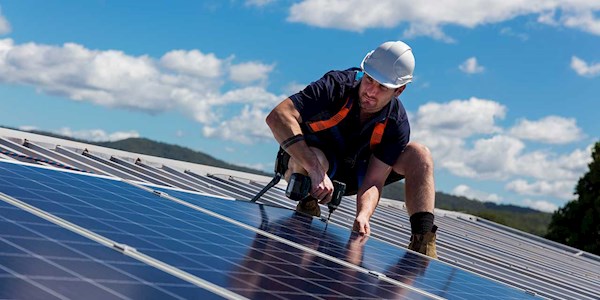
Roof-mounted solar photovoltaic (PV) panels can either be retrofitted to existing buildings or form part of a new-build project. From community centres and village halls to schools and healthcare facilities, solar panels are now a common sight on many community buildings.
Residents of social housing, too, are increasingly benefitting from the use of solar power to lower their electricity bills. Waverley Borough Council, for example, has around 450 council homes with solar panels, while St Albans City & District Council has recently been awarded an £8.45 million grant to improve the energy efficiency of social housing, including the installation of solar panels.1
Did you know?
- There are over 1.2 million solar PV installations in the UK. 2
- The average number of installations per month is 12,000. 2
- The cost of solar panels has reduced by 80% in the last decade. 3
A properly designed and installed solar panel system that is operating correctly should not pose a risk to the building to which is it fitted. However, like any electrical equipment, fires safety risks may arise if the equipment malfunctions or is damaged.
Poor quality componentry is the biggest fire risk factor for solar panels4 but something as simple as vermin chewing through a wire or a branch falling onto and cracking a panel could also lead to a fire breaking out.
When installing solar panels, it is vital therefore to follow the necessary safety guidelines.
Pre-installation
- Check that your roof does not contain combustible materials or insulation. Solar panels should ideally only be installed on non-combustible roofs, such as a concrete or clay tile pitched roof or a flat roof lined with non-combustible material.
- Confirm you have the authority for solar panels to be installed - if you do not have full
- Faulty electric meters can give incorrect readings so check your meter is not due to be replaced.
- Nominate a person with responsibility for administering the installation project.
Installation
- Check that your contractor is accredited to a national trade body such as the UK MCS Certification Scheme and the UK BS 7671 IET Wiring Regulations (18th edition or later), and has experience in both AC and DC systems.
- Solar panels, once in use, are considered to be constantly ‘live’, so your installer should provide a way to automatically isolate the panels. This could be a remote or integrated isolation switch, or isolation via your fire alarm system. The inability to isolate the supply of electricity from the panels to the building may delay firefighting operations.
- Solar panel cables should not be routed through rooms considered to be hazardous, such as boiler rooms, transformer rooms, flammable liquid storage rooms, etc.
- Solar panel arrays (strings of connected solar panels) should be kept at a distance of at least one metre from roof edges and roof vents to reduce the risk of a potential solar panel fire spreading.
Handover
- Your contractor has a responsibility to clearly explain to you as the building owner or occupier, the operational risks and safety features of your solar panel system. The handover should include detailed documentation relating to inspection and maintenance requirements.
- Ensure those responsible for the building operation have access to the documentation and understand the action to take and who to contact in the event of any suspected issues.
Maintenance
- Allow safe access for roof maintenance and cleaning with sufficient space on the roof itself to allow servicing and cleaning engineers to access the equipment, including panels, inverters and cables.
- Electrical maintenance should be performed by competent electrical engineers who are familiar with solar panel installations.
Annual inspection
- Check the condition of the panels - look for damage/discolouration and build-up of any debris/vegetation.
- Inspect the wiring and junction boxes - ;check for damage signs of water ingress.
- Check the fixing system, carry out a visual inspection of electrical components and ensure isolators are operating correctly.
- Keep a record of each inspection with photographic evidence.
- Carry out additional inspections following extreme weather events.
- Consider arranging thermographic inspections which are carried out via an infrared camera to detect power losses as well as defects that could lead to a fire.
Finally, organisations should include the risk of solar panel fires in their emergency response plan and incorporate this into the building’s fire risk assessment.
If you would like to speak to our team about the installation or maintenance of solar panels, or have any other risk management queries or concerns about your buildings, please get in touch.


